My wife and I are rapt in long distance train travel. It is the only way to see another country in comfort. You live in a luxurious hotel on wheels in the company of other like-minded souls and do trips to the hinterland of wherever the train decides to stop for a sightseeing tour. No airports, no changing hotels.
In 2008 a mate of mine and our wives embarked on a trip to India run by the same English company that did the Trans-Siberian; GW Travel. The tour was called Viceroy of India Darjeeling Mail. The real attraction for me was the Darjeeling Mail part, the most famous steam train journey in the world and an item on my bucket list. The names of places we visited are all the old fashioned ones. I can’t come to grips with the more enlightened names of places I learned about in school and have stuck with me ever since.
India may seem a strange place to go as a tourist. At school we learned that India was a place of masses of, disease, poverty and pestilence. The text books were wrong. The bad parts are worse than that and the good parts are never mentioned apart from the Taj Mahal monument at Agra.
The tour started at Bombay (Mumbai) and ended in Calcutta (Kolkata). Most of the way the train was pulled by diesel engines until we got to the Darjeeling Mail part. That was all steam.
The group assembled at the Taj Mahal Hotel in Bombay. I had been to India previously on business doing a consulting job to an Indian Government committee on tax reform. My meetings with the committee were at the Taj Mahal Hotel and I stayed there.

It is a most opulent hotel and three months after our group stayed there it was raided be terrorists and 31 guests and staff were killed. My memories of the place from my first visit were outside the entrance there was a dead woman lying on the footpath. Nobody seemed to care and people just walked around her. At lunch I was in a queue for a buffet. I was behind some Arabs dressed in their traditional robes but were speaking impeccable English. I got to chatting to them and asked one of them why, with all the wealth that they had, would they bother coming to a place like India? The reply stunned me: “Ah! You can buy a girl for 10 rupees per fortnight and only have to feed her once per day.” At the time a rupee was worth about 20 cents in our money. I quietly moved to the dessert queue.
The start of our trip was a tour of Bombay itself. Our main tour guide was an English educated Indian man. Very eloquent and impeccably dressed in a European manner. In fact all of the staff were men.He had full control over every Indian person we had to deal with or encountered. We were taken on a tour of two places that still amaze me. The first was a huge open air place adjacent to the main market square where lunches were prepared for workers throughout the city. 3 million lunches are prepared and delivered each day to workers who have ordered them. All prepared by hand and all delivered by men and boys in bare feet and wearing the usual nighties.
The second place was a huge open air laundry. I have no idea how many garments were laundered each day but, again, it would be in the millions; washed dried and in some cases ironed and, according to our guide, none go missing.

Poverty is all around wherever you go but we did not encounter any problems from beggars. The tour guide looked after us well in that respect. We spent two days visiting Hindu temples which, apart from the intricate carving and architecture, left no lasting impression.
We boarded the train that evening for dinner. The train itself was beautifully appointed in traditional Indian style. The dining room staff were so numerous that they were almost tripping over themselves. Dishes were brought from the kitchen car by women, then handed to a young male waiter who was supervised by a more senior male dressed in full traditional turbaned regalia who served the wine and gave orders to the staff.

The dining car arrangements were that there were two sittings based on your sleeper carriage number so you dined with the same group each time but as there was free seating one got a chance to mix with others. Each sitting had about 50 people. There was a good multi-national mix. 19 Americans, 6 South Africans, 4 Israelis, 4 Aussies, 1 Singaporean and a large collection of Poms. In the evening we all gathered around the piano for a good convivial sing song lubricated by more than a few drinks.
Our first stop was at Jaipur the capital of Rajasthan state. Jaipur is in the far north on the edge of a desert. Here one mixed with the picture post card throng with scores of elephants and camels filling the scene. The scene is much different from Bombay. Plenty of colourful ladies dressed in their traditional saris and caste marks.
Next was a brief journey to the city of Udaipur made famous by the James Bond movie Octopussy. This is a really lovely city. Built around two large lakes and in the centre is the famous Lake Palace which features in the movie.
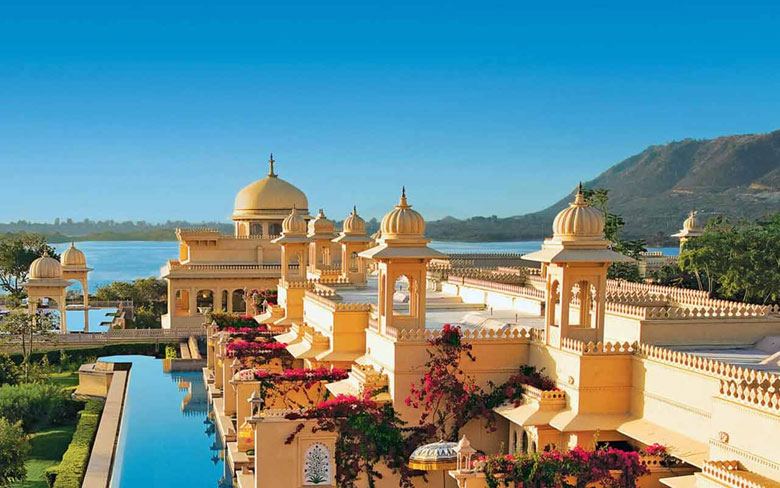
Udaipur is even more colourful than Jaipur and obviously benefits from being a major tourist destination. There are many impressive buildings in this area built during the reign of the Moghul Empire. There are large crowds of people everywhere but not in the same crushing quantity that one has to deal with in big Indian cities.
Our journey through northern India took us through a number of cities with impressive buildings from the Moghul era but apart from the visual impact, I am not a student of Indian history and culture so all one can do is enjoy the scenery. En route to our next stop, Agra, the guides gave us lectures of Indian history and culture which revealed some very interesting facts. Among other things it was revealed that India invented the numbering system and the digit 0, it invented the game of chess, the game of snakes & ladders, the art of navigation was developed on the River Sindh 6,000 years ago, the word “navigation” being derived from the Sanskrit word NAVGATIH. Until 1896 India was the sole source of diamonds in the world.
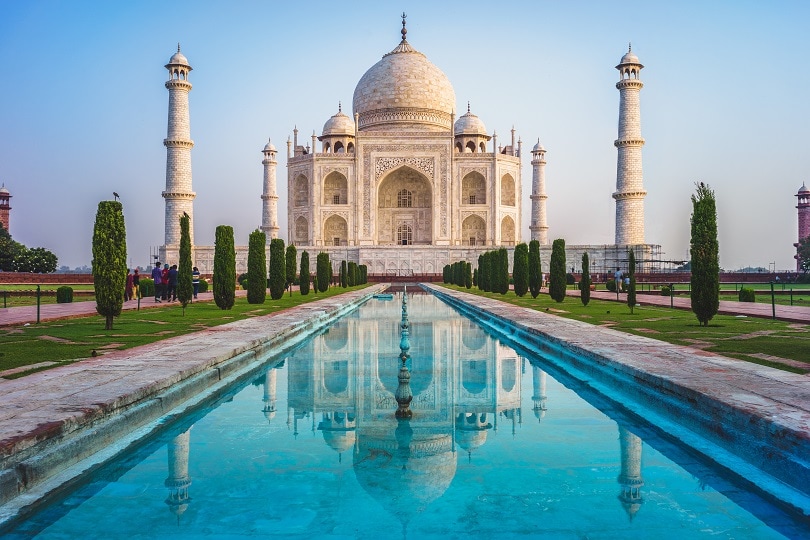
We arrived at Agra, famous for the Tal Mahal and achieving for me, the number 1 item on my bucket list. On my first trip to India I went to see the Taj. I was gobsmacked and vowed that one day I would take my wife to see it. The Taj is the most beautiful thing ever created by man. It is breathtaking in its beauty and magnificence. The white exterior is so brilliant that if one does not wear sunglasses you end up with a headache. The exterior is made up of millions of little white tiles all irregular shapes and all placed by hand.
The story behind it is by far the most romantic story ever told. Better by far than Romeo and Juliet or Antony & Cleopatra. It is a truly inspirational and emotional experience. The Taj was built by the Moghul emperor Shah Jahan as a monument to his favourite wife, Muntaz Mahal after her death in 1631. It took 20 years and 20,000 workers to build. On completion, the architect was thrown to his death from the front right hand pillar so that his skills could not be used to replicate it for another. Shah Jahan had a further plan to build an identical Taj in black marble as his tomb on the opposite side of the river. There was to be a bridge joining the two so that they could be united in death as they were in life.
Unfortunately, the Moghul empire expanded to the west of Agra and established a new city named Fatehpur Sikri but it was built on swampy ground and failed costing the Moguls much money. His son, locked him up in a tower at the Red Fort until he died in 1666. A century or so later saw the Moghul empire fall into decline and Agra ceased to be a power base.
Equally impressive in a different way is the Red Fort built on a bend of the river Yamuna by the emperor Akbar in 1565. It took 8 years to build and has a circumference of 2.5 kms. It was part of the Moghul strategy of conquering country then establishing a formidable defensive base to consolidate. Within its walls it is said to house a division of the Indian army. Based on the British order of battle which is followed by the Indian army, a division comprises about 30,000 troops. In the times I was there I never saw a single soldier.
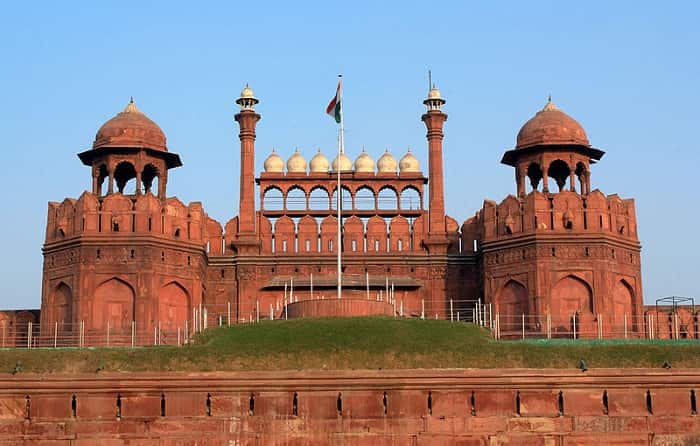
The fort has many beautiful features. It has beautiful carved marble walls and screens. From the harem quarters one looks along the river to the Taj with a lovely cool breeze wafting through the lattice work across the water. One can only imagine what it would have been like when dozens of beautiful girls dressed in their finery occupied these quarters. Taking one’s wife to see the Taj Mahal should be the #1 item on every man’s bucket list
The fort, the Taj and several other prominent buildings in Agra are world heritage listed. There is so much to see in Agra that one wonders why the whole city has not been so classified. Regardless of one’s religion it cannot be helped but to admire the craftsmanship and sheer beauty of the various mosques and religious structures built during the reign of the Moghuls.
Our next stop, not far away, was Delhi, capital of India. Delhi is divided into two parts; Old Delhi and New Delhi. Old Delhi is a place to be avoided unless one likes mixing in huge crowds. There is a mixture of Islamic and Hindu culture in this place. The Jama Masjid mosque is the biggest mosque in India. Our group visited it on a Friday and we departed in our buses just as the Friday prayers had concluded. The surge of masses of people in the streets, excited by their experience with Mahomed, alarmed our tour guide who instructed the driver to get out of the area ASAP. They just get worked up into a frenzy for no apparent reason and we were all very relieved to get back to some area of relative safety.
My favourite place in Delhi is the world heritage listed Qutb complex, a Hindu monument of seven structures of which the most prominent is the Qutb Minar, a minaret built in 1199 as a victory tower.
It is 72 metres tall, built over a Hindu temple it is a monument to victory and not a place of worship. However, even more impressive in this complex is the Iron Pillar, a free standing pillar of iron, some say was erected during the reign of Chandragupta between 375 and 425 BC.

It is 7.21 metres tall and stands entirely in the open. It has been studied by scientists for well over 200 years and is conceded to be 99+% pure iron but it is not rusty. Its composition and method of manufacturing has been a topic of conjecture for centuries and it was only in 1969 that some consensus was reached when Erich von Daniken, of Chariots of the Gods fame, published an explanation which is now more or less universally accepted.
The other place of interest in Delhi is the Indian National Railway Museum. Here are examples of every piece of rolling stock used by the Indian Railways in the past 170 years.
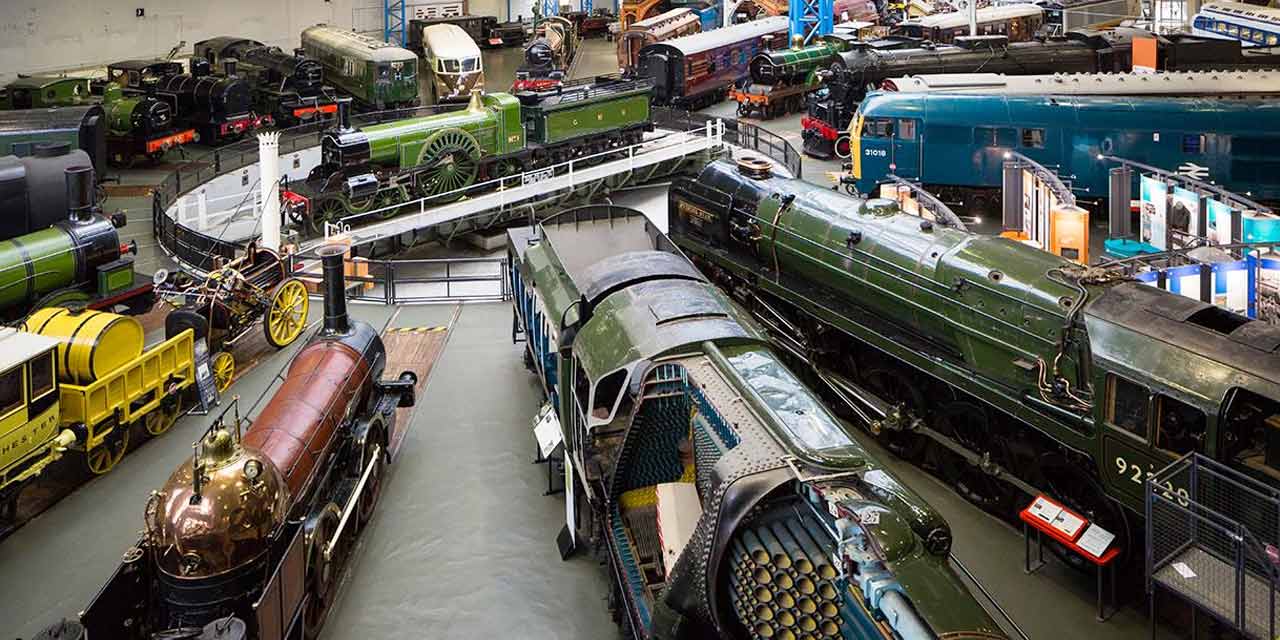
The British Raj gave India two of its most valuable assets. One was the English language. Two was the railway system. Indian Railways is the largest employer in India with about 1.8 million staff. The country could not survive without it. On all lines we travelled on trains were packed to the brim with people. They ride on top of the carriages, on the locomotives and hang off the sides and as well as that every train track has a column of people walking in both directions on each side of the tracks.

We then moved on to the city of Varanasi on the banks of the Ganges River. Previously called Benares it is the holiest Hindu place in the world. Heavily populated, filthy in the extreme it is the worst place I have ever been to; utterly disgusting. Hindus come here to die and be cremated. Cows roam the rubbish strewn streets looking for something to eat as there is no grass growing anywhere. Pilgrims bathe in the filthy Ganges water to cleanse their souls at risk of ingesting some fatal disease. An occasional dead body of a baby can be seen floating past. The hills around are jam packed with houses owned by the wealthy just to be able to absorb the holiness of the place. Along the riverbank there are pyres built of wood to burn the bodies of the dead. Cremation by this method is expensive so a pyre can contain 50 or more bodies to reduce the per capita cost. Arms and legs of the dead can be readily seen protruding from the pyres and the aroma of burning flesh and smoke is constant. The fires burn 24 hours per day. Never did Melbourne look as good as my mate and I sat on a wall with an American couple discussing the pros and cons of Obama being elected. At this point the Ganges is a very wide and fast flowing river. The world would be a better place if this city just sink into its depths.
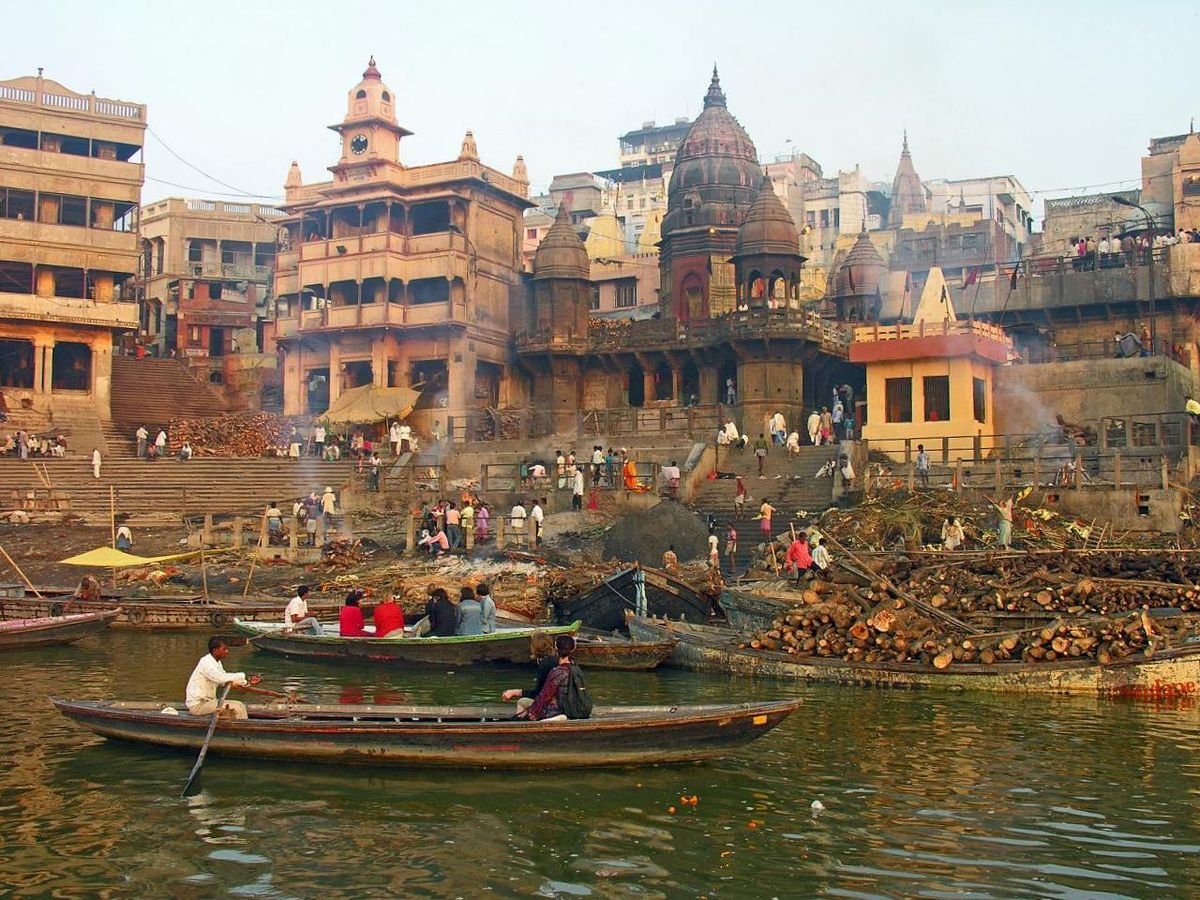
Our next stop was the end of luxury and the terminus of the Darjeeling Mail Railway. Starting on a plain in Assam at the foothills of the Himalayas, this railway is only one of two world heritage listed railways. The whole system was built by the British in the 1880’s and much of the rolling stock is of that vintage. The oldest engine still in operation was built in 1889. The line is 24 inch gauge to enable it to traverse the tight curves. It rises to 7,400 feet to its main terminus at Ghum and continues on to Darjeeling.
Our little engine took off in a very pleasant run up modestly sloping hills which became steeper as we progressed. At each rise in elevation the little engine struggled until we reached a point where it could go no further so the passengers all had to get out and push the train up the hill to the next reasonably level ground. There, the engine was uncoupled and continued to Ghum while we all waited for the replacement engine to arrive. Arrive it did and we were then in the Himalayas proper.
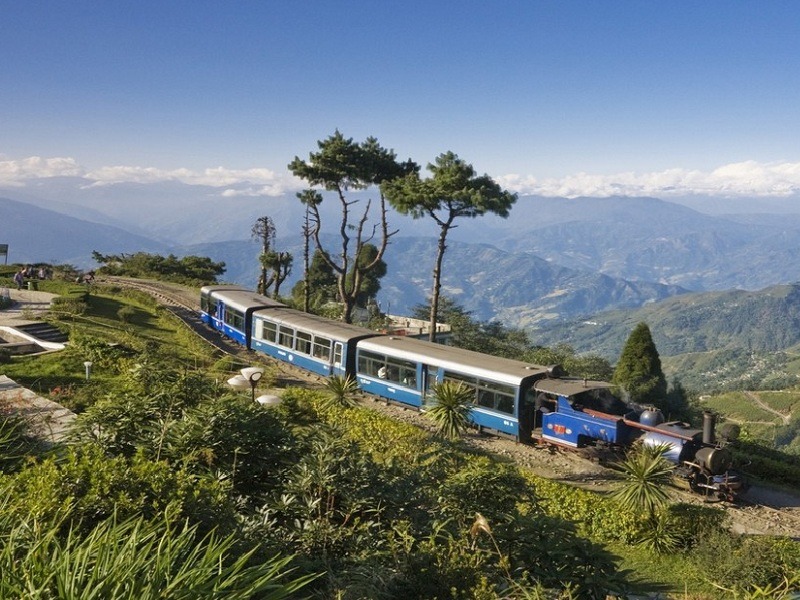
Magnificent scenery, tea plantations as far as the eye could see and beautiful cool weather. We arrived at Darjeeling, a beautiful town nestling in the shadow of Kankenchunga, the third highest mountain in the world. Darjeeling was established by the British as a place to escape the oppressive heat of the lowlands and as a sanatorium for troops and officials. There are many lovely old fashioned guest houses still being used and we stayed at one named Windamere, a beautifully preserved property of the British Raj Colonial era and the oldest remaining hotel of that era.
As one moves up into the Himalayas the people change dramatically. Down on the plains of Assam they are all Indian but when one reaches a certain elevation they are distinctly oriental and there are fewer of them. Some years ago there was a movement by these people to separate from India and join up with Nepal to form a new country called Gorkaland. The Indian government persuaded them to drop these plans by offering substantial financial assistance but the ethic of the place is very much a part of a Gurkha community and the Gorkaland movement is still alive and well.
I was fortunate to be able to buy a beautiful matched pair of kukris, the traditional fighting knife of the Gurkhas. The kukri is a perfectly balanced and most lethal knife, razor sharp and I was allowed to bring them back to Australia on the basis that they were trophies. Tradition has it that a kukri, once withdrawn from the scabbard should not be replaced unless it has drawn blood. Consequently Gurkha people nick a fingertip or an ear lobe to draw blood. My pair hung in my office for some years until my little granddaughter refused to come in because she was frightened of it so my wife insisted that I remove them and they now reside under my bed just waiting for some of these home invaders to try their luck at our house. There was a large one used to behead a bullock in one single stroke in the Marlon Brando movie Apocalypse Now.
Darjeeling is surrounded by tea plantations on steep slopes where all the tea is plucked by hand. There are warehouses with dried teal eaves in piles like one sees in sugar warehouses in Queensland. Every leaf has been picked by hand. Darjeeling tea is of the highest quality thanks to the cool climate.
One morning we rose at 3.00am and took a bus to an observation deck up the mountain to watch the sun rise over the Himalayas. A most spectacular sight that lasts only a few minutes. Looking to the west one can see the tip of Mt,Everest shining like a giant inverted ice cream cone some 400 miles away. A truly unforgettable experience.
Our stay at Darjeeling lasted a few days then we were off by bus to Calcutta. On the way down as we reached the plains of Assam we tagged on to the end of an Indian Army convoy and passed through massed crowds of people. Our guide told us that we were lucky to meet up with the army column because it was a frequent practice of these people to hold up buses and demand cash from the passengers before they would allow the bus to proceed.
I don’t recall much of Calcutta except that there were cows wandering on the freeway and the traffic had to stop until the cows were ready to move. One did nor shoo them away. The only other point of note was the cricket ground which seats 140,000 people.
Then on to the airport to catch our flight to Seoul. Our Indian odyssey was at an end and with it many memories of the good and the bad of human life. A Great experience in living history and one which I would not recommend to intrepid travellers unless it is undertaken with a very good guide. The daily return to our luxurious train was always a great relief but warts and all it is a journey that I would thoroughly recommend.
There is danger travelling in India alone or as a couple, especially if you are elderly. It comes from the masses of beggars who swarm around all the major attractions like blowflies fighting each other to get to the front and put their pleading hands in your face. They can be counted in hundreds and the danger is the sheer weight of their numbers rather than any malice of forethought. They are driven by poverty unknown to us.
BLOG COMMENTS POWERED BY DISQUS

